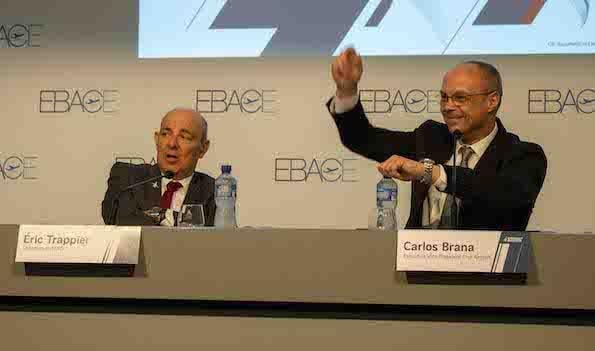
Dassault President and CEO Eric Trappier (left) and Executive Vice President of Civil Aircraft Carlos Brana (right) gave an update on the Falcon 6X and 10X at EBACE. Since the Boeing 737 MAX crisis, aircraft certification has become a longer exercise, Trappier emphasized.
GENEVA—Facing high anticipation for the Dassault Falcon 10X, President and CEO Eric Trappier noted that Dassault is navigating in a “very turbulent world.”
“We have conflicts in Ukraine and in the Middle East, higher interest rates, which, since inflation is going down, should go down as well,” Trappier said during Dassault’s press conference at the European Business Aviation Convention & Exhibition (EBACE) here.
Despite rising geopolitical tensions and economic strains, Trappier expressed confidence in Dassault’s market performance. The airframer’s newest long-range jet, the Falcon 6X, entered service last year and has demonstrated exemplary performance, according to Dassault.
“As of today, it has flown more than 500 hr. in less than six months,” Trappier said. “Sometimes, it conducts four 2-hr. demo flights a day. It flew from Paris to Sao Paulo in 12 hr. and 43 min. against stronger-than-average winds. During that flight, it flew farther than a book range of 5,500 nm.” According to Trappier, the Falcon 6X flew 5,646 nm during that flight and landed with “higher than needed” fuel reserves.
Not unlike the rest of the industry, Dassault is facing challenges incurred by supply chain stressors.
“It has not yet stabilized, particularly among French suppliers, but not only,” Trappier said. “We are working with them to correct the situation, but we do not expect all issues to be fully resolved this year. They are facing cash and workforce issues, which are necessary to the successful ramp-up expected by the industry.”
Subsequently, the supply chain roadblocks have affected the launch of Dassault’s next ultra-long-range jet, the Falcon 10X.
“As of now, the first examples of major assemblies—the all-composite wings, the fuselage and empennage sections—have been assembled in Dassault and partner facilities,” he said.
Final assembly of the Falcon 10X was originally expected to begin in the latter half of 2024, but it is now projected for 2025. As a result, the first 10X deliveries have been delayed until 2027.
The Falcon 10X is powered by Rolls-Royce Pearl 10X engines, which are being tested on a Boeing 747 testbed platform. According to Trappier, the engine ran in a test cell using 100% sustainable aviation fuel.
Additionally, FAA and European Union Aviation Safety Agency (EASA) certification of the Falcon 10X has been complicated due to recent accidents involving Boeing aircraft.
“For me, the work has been a little more difficult,” Trappier said. “Not because there was a change in EASA or FAA, but because of Boeing events. The rules are changing, and we need to adapt to the new rules. My recommendation to all aircraft manufacturers is that the certification process has to start at an early stage of development of a new program, because it takes a long time to proceed. Then you need to do it in confidence, and even with confidence, even when you are starting early, at the end, it takes time.”
